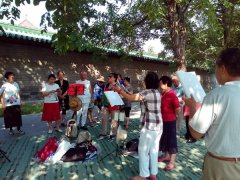Feature: Good tea in Taiwan starts at school
TAIPEI, April 23 (Xinhua) -- It is mid-April. Just after 5 a.m., Chen Siou-cin, 60, puts on her bamboo hat and goes to her tea garden.
Her garden covers 1.5 hectares and is set on a low ridge in Taiwan's Nantou County, 200 kilometers from Taipei. Chen has been growing tea here for more than 30 years.
She plucks the top two leaves and bud from the new shoots -- an action she has repeated millions of times.
Her tea garden is only at 400 meters high, an elevation usually too low for quality tea.
Good tea comes from a suitable environment -- plenty of rain; fertile soil; low , diffuse sunlight -- which is why the highlands outperform the plains.
But industrious tea growers in Taiwan have developed new strains of tea trees over many generations that thrive low-altitudes and also make good tea.
Brought from the Chinese mainland just 100 years ago, tea can be seen almost everywhere in Taiwan, at altitudes ranging from 100 meters to over 2,200 meters.
A warm winter and late spring, and poor rainfall this year have postponed the harvest.
"We usually have it done by Qingming Festival," said 46 year-old Chen Sung-fei.
Chen Sung-fei runs a small tea-processing plant. The juicy leaves plucked by Chen Siou-cin and other tea pickers are sent here with no time wasted.
The leaves are first put in the sun to pull out the moisture, known as "sunlight wilting." There must be plenty of sun, but not too strong, with a gentle breeze.
"If we feel comfortable, the tea leaves feel the same," he said.
The tea leaves are then moved inside for a series of other steps, including fermentation, "kill-green," rolling and drying, before being put on sale.
"It usually takes one and a half days, or two days at most to make tea from leaves," Chen Sung-fei said. "Too much time will affect the taste."
Nantou is Taiwan's largest tea producer, with more than half the tea trees planted on the island over the past 20 years.
Statistics from Taiwan's agricultural department showed the 11,780 hectares of tea plantations in Taiwan produced 14,000 tonnes of tea leaves last year, of which over two thirds came from Nantou.
"Output in Nantou is expected to drop by one-third this year due to the weird weather," Tseng In-wei, official at the Nantou agricultural department told Xinhua. An output fall here means a rise in local tea prices.
Taiwan's tea, especially the high-mountain Oolong tea, has a good reputation, but output hardly meets local demand. Taiwan exports very little tea each year, in fact, it imported 26,000 tonnes of tea, mostly from Vietnam in 2016.
Most of the imported tea goes into make another Taiwan-style beverage -- freshly-brewed tea drinks -- as they are cheaper.
Data from the statistics bureau showed the average per kilo price of exported Taiwan tea was 11.90 U.S. dollars last year, five times the price of imported tea.
A report from the economic authority showed how deeply consumers in Taiwan love tea drinks: one billion cups of tea drinks were sold in 2015, with 44 cups for per person a year. But seldom do they knew they are actually drinking imported tea.
To revive the traditional tea culture, primary schools in Nantou County have been teaching children to recognize, taste and prepare tea.
Chen Jien-ling, 28, started to learn Chayi, or the art of drinking tea at age nine. She now teaches the Chayi in primary schools in Nantou.
"The kids change a lot in behavior after learning to make tea," she said. "The naughty ones learn to meditate and become more courteous."
"We hope our children fall in love with tea at a young age, so that the traditional Chinese tea culture will not diminish," said Chen Jeng-sheng, deputy head of Nantou County.















